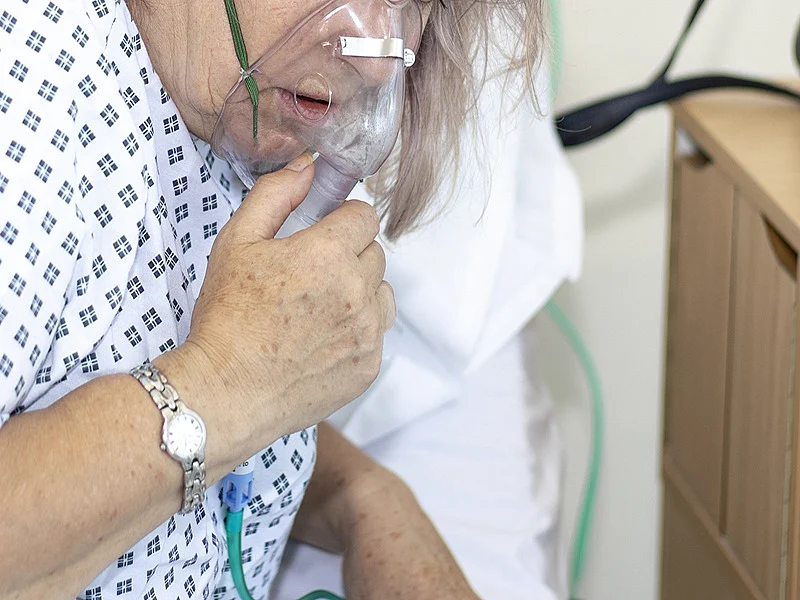 By way of Dennis Thompson HealthDay Reporter
By way of Dennis Thompson HealthDay Reporter
TUESDAY, April 19, 2022 (HealthDay Information)
Putting hospitalized COVID-19 sufferers on their abdomen is beneficial if they are on a mechanical ventilator, however a brand new learn about suggests it is not a good suggestion for sufferers who don’t seem to be intubated.
“Unsleeping” COVID sufferers — versus ventilated sufferers who’re saved sedated — didn’t take pleasure in mendacity on their abdomen whilst suffering for breath, in keeping with scientific trial effects printed on-line April 18 in JAMA Inner Medication.
Actually, conscious COVID-19 sufferers requested to vulnerable did moderately worse non permanent than the ones left on their backs, stated lead researcher Dr. Todd Rice, an affiliate professor of hypersensitive reaction, pulmonology and demanding care medication at Vanderbilt College in Nashville, Tenn.
Their blood oxygen ranges have been decrease, and so they tended to stay sicker, Rice stated.
After 5 days of proning, “fewer of them have been discharged to house and extra of them have been on mechanical ventilators than the gang that did not vulnerable,” he stated.
Proning is a method for making improvements to oxygen ranges in ventilated sufferers that is been practiced for many years in the USA, and former scientific trial effects have supported its use, stated Dr. Peter Sottile, an assistant professor of pulmonology and demanding care medication on the College of Colorado, in Aurora.
Within the early days of the pandemic, determined medical doctors began to invite conscious COVID-19 sufferers to vulnerable as neatly, Sottile stated. The hope was once that proning would stay sufferers’ oxygen ranges prime sufficient that they would not wish to pass on a ventilator — units that have been in desperately quick provide.
“In March of 2020, when Italy and New York have been being overrun and there have been vital considerations about whether or not we are going to have sufficient ventilators for these kinds of sufferers, and what are we able to do to check out to stay other folks off the ventilator — that is when vulnerable positioning of conscious sufferers actually got here again as one thing to believe and notice if it really works,” stated Sottile, who wrote an article printed April 18 with the brand new learn about.
Medical doctors may level to 1 COVID affected person or some other and say that proning had helped stay them off the ventilator, however such anecdotal proof does not turn out it is an efficient technique, Sottile stated.
Additional, some observational research had proven that asking conscious sufferers to vulnerable may make stronger their oxygen ranges, however the ones research did not display whether or not it saved their COVID from progressing, Rice stated.
So Rice and his colleagues recruited about 500 hospitalized COVID-19 sufferers to check whether or not proning in truth would lend a hand them. Kind of part selected at random have been requested to lie on their stomachs for so long as they may each day.
By way of day 5, the proning sufferers have been much more likely to be worse off than sufferers left on their backs, the learn about effects confirmed.
“Sufferers over the ones first 5 days incessantly were given worse within the proning staff,” Rice stated. “They regarded somewhat worse every day than the supine staff, suggesting that it is a slowly revolutionary worsening and now not an acute procedure the place anyone grew to become over and all at once they were given in poor health.”
After 28 days, the 2 teams had no variations in the case of loss of life, their development to mechanical air flow, or duration in their sanatorium keep.
There are a few imaginable explanations for why conscious sufferers would possibly now not reply neatly to proning, Rice and Sottile stated.
First off, conscious other folks cannot very easily lie on their stomachs for so long as subconscious ventilated sufferers, so they won’t have the ability to keep vulnerable lengthy sufficient to take pleasure in the location.
“It is not that comfy for conscious other folks to put on their abdomen for lengthy sessions of time, so we inspire them to vulnerable for so long as they are able to in all probability tolerate it,” Rice stated. “And that grew to become out to be on moderate about between 4 and 5 hours an afternoon.”
That is a long way much less time within the vulnerable place than has been required in ventilated sufferers to be efficient, Sottile stated.
“Previous research have proven that we want 16 hours or extra an afternoon within the vulnerable place to obtain receive advantages,” he stated. “Asking an conscious affected person to put on their abdominal for 16 hours an afternoon is actually most probably now not possible. It is a laborious factor to invite somebody to do day in and time out.”
Additionally it is imaginable that proning would possibly in truth lend a hand unfold the virus or irritation to still-healthy portions of the lung, Rice stated, “versus when you are at the ventilator and your entire lung is already concerned.”
He stated medical doctors who deal with COVID-19 sufferers would possibly need to reconsider asking them to vulnerable whilst they are nonetheless neatly sufficient to be off a ventilator.
“There are numerous pointers that recommend doing this in sufferers who don’t seem to be but routinely ventilated,” Rice stated. “I feel our learn about throws a bit of warning” relating to the ones pointers.
Additional information
Penn Medication has extra on proning COVID sufferers.
SOURCES: Todd Rice, MD, affiliate professor, hypersensitive reaction, pulmonology and demanding care medication, Vanderbilt College, Nashville, Tenn.; Peter Sottile, MD, assistant professor, pulmonology and demanding care medication, College of Colorado, Aurora; JAMA Inner Medication, April 18, 2022, on-line

Copyright © 2021 HealthDay. All rights reserved.
